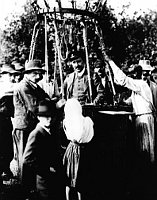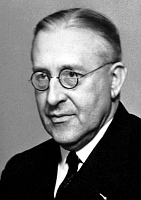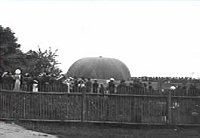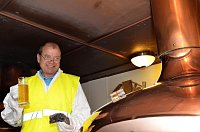Czechs toast the discovery of cosmic rays 100 years ago this week
CR: In the early morning hours of Tuesday a crowd gathered to watch the release of a hot air balloon over Prague’s Libuše meteorological observatory in honour of the 100th anniversary of the discovery of cosmic rays by the young Austrian physicist Victor Franz Hess. But, more than anywhere else the anniversary is being marked in the town of Ustí nad Labem where Hess’ successful balloon flight took place exactly a century ago.
 Victor Franz HessAt the end of the 19th century scientists discovered radioactivity and puzzled over the fact that the air in electroscopes-instruments for detecting electrical charges -became electrically charged no matter how well the containers were insulated. It was thought that radioactivity from ground minerals was responsible and physicists conducted various experiments to prove this theory. The most persistent of them was the German Jesuit Theodor Wulf. Physicist Jiří Grygar of the Czech Academy of Sciences explains:
Victor Franz HessAt the end of the 19th century scientists discovered radioactivity and puzzled over the fact that the air in electroscopes-instruments for detecting electrical charges -became electrically charged no matter how well the containers were insulated. It was thought that radioactivity from ground minerals was responsible and physicists conducted various experiments to prove this theory. The most persistent of them was the German Jesuit Theodor Wulf. Physicist Jiří Grygar of the Czech Academy of Sciences explains:
“Teodor Wulf first descended into a series of underground caves thinking that the closer he got to the core of the earth the stronger the radiation would be and expected it to gradually diminish as he ascended. In fact he climbed to the top of the Eiffel tower to see it diminish but the measurements failed to prove his theory. That inspired Hess to think along different lines –that the radiation could be coming from space and he had the idea to go up in a balloon to prove it.”
So did a few others and between 1909 and 1912 several scientists made their own experimental flights in balloons but none of them provided any substantiated evidence for where the radiation could be coming from.
Victor Franz Hess, a 29-year-old assistant at the University of Vienna, was not put off by their lack of success. Before making balloon ascents himself, he figured the height at which ground radiation would stop producing ionization (about 500 meters) and designed instruments that would not be damaged by temperature or pressure changes. Eleven balloon flights proved unsuccessful mainly because his coal-gas powered balloons could not ascend to a proper height. That led him to the town of Ustí nad Labem which offered a solution to many of his problems. Martin Krsek from the Ustí nad Labem Museum explains:
 Martin Krsek, photo: archive of the Ústí nad Labem Museum“At the time Usti nad Labem boasted the biggest chemical factory in the Austro-Hungarian Empire. It produced plenty of hydrogen, very clean hydrogen, which would take Hess much higher and moreover had experience in using it to power balloons. And even better, the town was home to the German Balloon Enthusiasts’ Association.”
Martin Krsek, photo: archive of the Ústí nad Labem Museum“At the time Usti nad Labem boasted the biggest chemical factory in the Austro-Hungarian Empire. It produced plenty of hydrogen, very clean hydrogen, which would take Hess much higher and moreover had experience in using it to power balloons. And even better, the town was home to the German Balloon Enthusiasts’ Association.”
The association agreed to lend him their biggest balloon called Bohmen and Victor Franz could set the date – August 7, 1912. Thanks to auspicious weather conditions his balloon was able to take off shortly after 7am that morning. The flight gave the young scientist the evidence he craved, but it was by no means easy. Martin Krsek again:
“The instruments that Hess used to measure the radiation were of course very primitive. It meant watching them and taking notes all the time. As the balloon ascended he felt weak and had to inhale oxygen. Originally Hess planned to reach a height of 6 kilometres but when he reached just over 5000 metres he feared he would pass out and started descending, registering the radiation both on the way up and down which was important for his discovery. He finally had proof that the radiation detected on Earth came from space.“
 Victor Franz HessAlthough the discovery won him the Nobel Prize in Physics in 1936, (a prize he shared with Professor Carl D. Anderson from the California Institute of Technology who had discovered the positron) it got surprisingly little attention at the time. The local media barely mentioned it. However the monarchy was generous in its support for scientists and gave Victor Franz Hess his first grant.
Victor Franz HessAlthough the discovery won him the Nobel Prize in Physics in 1936, (a prize he shared with Professor Carl D. Anderson from the California Institute of Technology who had discovered the positron) it got surprisingly little attention at the time. The local media barely mentioned it. However the monarchy was generous in its support for scientists and gave Victor Franz Hess his first grant.
“He really asked for grant money on his return – from what we would now call the Academy of Sciences and he was not turned away. His scientific experiments were quite costly. The single balloon trip in Usti amounted to 540 Austrian crowns, which was a tenth of a balloon’s purchasing price. “
In 1920 he became an associate professor of experimental physics at the University of Graz and a year later he took a leave of absence to make his first trip to the United States, where he became chief physicist and director of a research laboratory, built under his supervision.
Hess returned to the University of Graz in 1923 where he was made a full professor. In 1931, the now widely respected physicist accepted a position as professor of experimental physics and head of the institute for radiation research at the University of Innsbruck. With the support of the Rockefeller Institute, the Austrian Academy of Sciences, and the Society for German Sciences, Hess founded in the autumn of 1931 a station for the observation of cosmic radiation on Hafelekar mountain near Innsbruck at a height of 2,300 meters.
 Victor Franz Hess’ balloonIn 1937 prof. Hess returned to the University of Graz but his days in Europe were numbered. Two months after the 'Anschluss' in March 1938, he was dismissed from his post because he had a Jewish wife. After receiving warning of impending arrest, the Hesses fled Austria to Switzerland and eventually the United States where he was offered a full professorship at Fordham University in New York. In 1944 Victor Franz Hess was granted American citizenship. His research in later years included investigating the possibility of producing rain artificially and determining the effects of atomic bomb tests in terms of radioactive fallout.
Victor Franz Hess’ balloonIn 1937 prof. Hess returned to the University of Graz but his days in Europe were numbered. Two months after the 'Anschluss' in March 1938, he was dismissed from his post because he had a Jewish wife. After receiving warning of impending arrest, the Hesses fled Austria to Switzerland and eventually the United States where he was offered a full professorship at Fordham University in New York. In 1944 Victor Franz Hess was granted American citizenship. His research in later years included investigating the possibility of producing rain artificially and determining the effects of atomic bomb tests in terms of radioactive fallout.
Although prof. Hess’ link to Ustí nad Labem, much less the Czech Republic, is tenuous, his legacy has not passed unnoticed. The anniversary of his discovery of cosmic radiation has inspired an exhibition on his research and other scientific discoveries the town contributed to – and in true fashion Czechs are toasting the discovery of cosmic radiation with a special brand of beer called Cosmic produced by a small local brewer. Martin Krsek explains how the idea emerged.
“We wanted a beer special to mark the occasion and we asked this small brewery Na Rychte to cooperate with us. The Cosmic label was pretty obvious but we wanted a stronger connection to the discovery so we suggested they add radioactive water to the brew. The chief brewer was not impressed, arguing that it would put people off drinking it and kill the whole project, so that was that. But we really wanted this cosmic beer to “radiate” so we selected a small piece of uranium from the local museum and walked around the brewery with it while the beer was being brewed – just to complete the symbolism so to speak.”
 Photo: Hotel Na Rychtě BreweryThe Cosmic brew can be sampled at an exhibition devoted to professor Hess’s work in Usti, where visitors can view old photographs, faded newspaper clippings reporting on his discoveries and instruments used by scientists in the late 19th and early 20th centuries. Martin Krsek says the exhibition reflects not just the mood of the times, but provides a lot of insight into the personality of Viktor Franz Hess.
Photo: Hotel Na Rychtě BreweryThe Cosmic brew can be sampled at an exhibition devoted to professor Hess’s work in Usti, where visitors can view old photographs, faded newspaper clippings reporting on his discoveries and instruments used by scientists in the late 19th and early 20th centuries. Martin Krsek says the exhibition reflects not just the mood of the times, but provides a lot of insight into the personality of Viktor Franz Hess.
“He was typical of the breed of scientists that emerged in the late 19th and early 20th centuries. A man who thirsted for discoveries and for whom no risk was too great to take in the process. This scientist was certainly no bookworm closeted in an ivory tower. He made many personal sacrifices on the road.“
Daniela Lazarová, Zdenka Kuchyňová
